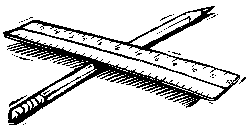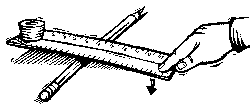Secrets of Lost Empires I—Obelisk
|  |
Student Handout |
Lever Loads
You've got a massive stone to lift into place and plenty of people to help you,
but all you get is a bunch of people grunting. What do you do? Turn to a lever,
of course. NOVA's team of experts assumed this simple machine was available to
ancient Egyptians and believed it played a part in raising the giant obelisks.
Try your hand at investigating how levers make work easier.
Part I
Do this part individually.
Procedure

Set up a lever by placing a ruler on top of the pencil as illustrated. The
ruler acts as the two lever arms. The pencil that it pivots or balances on is
called the fulcrum. Place a load of five coins or washers (taped together in a stack) at one end
of the ruler on the 2.5 cm (1 in.) mark. Lift the load by pressing down at the opposite end of the ruler using one
finger. Notice how hard you need to press to lift the load.

Change the position of the pencil and press to lift the load. Try several
different positions. Each time notice how hard you press in order to lift the
load.
Questions
Write your answers on a separate sheet.
Where is the pencil fulcrum when it feels easiest to lift the load? Where is the pencil fulcrum when it feels hardest to lift the load? Was there an instance when the load was lifted without any effort? How can you explain this?
Part II
Do this part with a partner.
Procedure
Place the load at the 2.5 cm (1 in.) mark. Place the pencil fulcrum under the
15 cm (6 in.) mark. As your partner presses down on one end, measure the distance the load is
lifted up (d1). Next, measure the distance the other end of the lever moves as
your partner presses down (d2). Draw a picture showing the distances and
compare.

Move the fulcrum to a position where you have to push hard to lift the load.
Again, measure the distance the load is lifted and measure the distance the
other end of the lever moves down. Compare these distances. Draw a picture
showing the distances that each end of the lever moves. Move the fulcrum to a position where you only have to push lightly to move
the load. Make the same measurements as above and draw your results.
Questions
Write your answers on a separate sheet.
Compare the distance the load was lifted when you pushed hard to when you pushed lightly. What do you notice? What role does the fulcrum play in determining how much you have to push to raise the load? If you needed to lift a load of ten quarters using ten pennies as the force, would you place the fulcrum closer to the pennies or the quarters? Explain.
| 